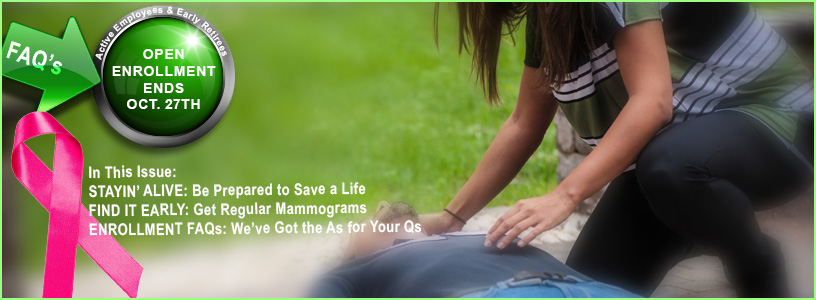STAYIN’ ALIVE: Be Prepared to Save a Life
More than 356,000 people experience sudden cardiac arrest in the U.S. every year. Buffalo Bills player Damar Hamlin and USC basketball player Bronny James are recent, high-profile incidences of sudden cardiac arrest.
Sudden cardiac arrest is the sudden loss of all heart activity due to an irregular heart rhythm. Breathing stops. The person becomes unconscious. Without immediate treatment, sudden cardiac arrest can often lead to death.
Anyone can have sudden cardiac arrest, and the risk increases as we get older. African American men and people with coronary heart disease (or a genetic cause of heart disease) have a higher risk.
About 60% to 80% of people having sudden cardiac arrest die before reaching the hospital. However, your quick response can greatly improve a victim’s chance of survival. Here’s what you can do:
- If you see someone who's unconscious and not breathing, call 911.
- Then start CPR. Watch this short video from the American Red Cross to refresh yourself on how to do CPR to the tune of “Stayin’ Alive” (the Bee-Gees must be so proud): Hands-Only CPR: 2 Steps to Save a Life.
- Use an automated external defibrillator (AED), available in many public places. AEDs come with step-by-step voice instructions for their use and are programmed to allow a shock only when appropriate.
Being prepared now will help you step into action later. Who knows, maybe you’ll save the life of someone you love. #SuddenCardiacArrestAwarenessMonth
Resources
- Providence: Heart Attack or Cardiac Arrest?
- Kaiser Permanente: Cardiac Arrest
FIND IT EARLY: Get Regular Mammograms
When breast cancer is detected early, and is in the localized stage, the 5-year relative survival rate is 99%. About 240,000 women are diagnosed with breast cancer each year in the U.S.
Even women who have no symptoms and no known risks for breast cancer should have regularly scheduled mammograms to help detect potential breast cancer at the earliest possible stage. The U.S. Preventive Services Task Force recommends:
- Women who are 50 to 74 years old should have a mammogram every other year.
- Women who are 40-49 with a higher risk for breast cancer should talk to their doctor about having mammograms.
- Women younger than 40 should talk to their doctor about their breast cancer risk.
Your Health Plan covers mammograms (and all preventive services recommended by the USPTF) at 100% when you use an in-network provider. October 21 is #NationalMammographyDay, and the best way to observe this day is to schedule your next mammogram.
#BreastCancerAwarenessMonth
Resources
- National Breast Cancer Foundation: Early Detection
- Providence: Mammography
- Kaiser Permanente: Mammogram Guidelines
ENROLLMENT FAQs: We’ve Got the As for Your Qs
Open Enrollment for Active Employees and Early Retirees continues through Friday, October 27. Here are the top questions employees ask:
- Do I need to enroll this year? YES, if you want to change your selections, have an FSA in 2024, or if you aren’t yet enrolled at all but want to have benefits in 2024.
- Do I need to enroll if I want to keep my current selections? NO, your current benefit choices will roll over to the 2024 Plan Year (except FSAs).
- What is my current Health Plan choice? Find out on PPS Self Service (Active Employees) or Zenith Participant Edge (Early Retirees).
- Where can I see all of my benefit options? Your Enrollment Packet provides everything you need to compare your options. (Didn’t receive one? Call the Trust Office at 833-255-4123.)
- How can I find out if a specific service is covered? See your Benefit Handbook or call the Carrier.
- How do I know which dependents are already enrolled? Find out on PPS Self Service (Active Employees) or Zenith Participant Edge (Early Retirees).
- Which dependents are eligible to enroll? Click here: Eligible Dependents.
If you have any benefits questions, including how the Trust Plans coordinate with other coverage, please call the Trust Administrative Office before you enroll.


